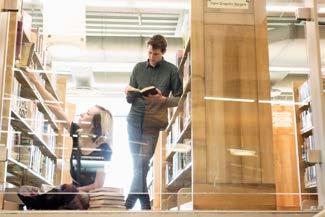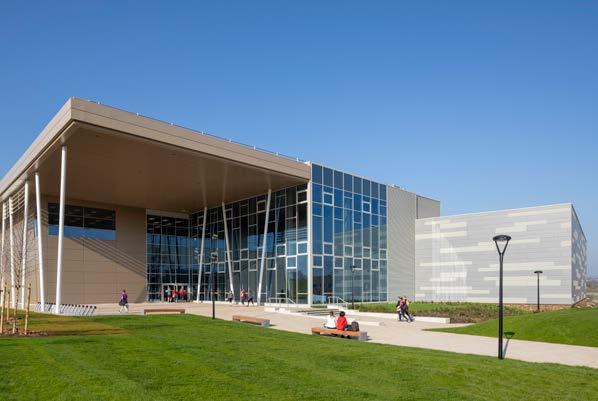
5 minute read
Smart campus
Students work and live in an eclectic mix of buildings; from the venerable, centuries old to the ultramodern and everything in between, often on the same campus. The question must be asked whether the buildings have an impact on the student experience, enjoyment and academic achievement? The answer is an emphatic yes! Old or new, campuses need to get smart to serve their student population effectively and economically.
Buildings old or new can become ‘Smart’ Buildings that interact with people, systems and external elements around them. Learning from real-time inputs, they can adapt to the needs of the people within them to improve the safety, learning environment and comfort of students and staff. At the same time, they can increase efficiency and resilience.
Toxic air
At a practical level, for example, air quality in old draughty buildings may be better than that in modern “hermetically sealed” ones. As we breathe in, we inhale about 400 parts per million (ppm) of CO2, when we breathe out we exhale 40,000 CO2 ppm; it’s not surprising that CO2 concentrations in seminar rooms or lecture theatres, where population density is higher, often rise far beyond the acceptable level of 1,000ppm. If the CO2 in the room increases to 2,500 ppm and beyond, which is not uncommon, our ability to use information drops by 60% and our initiative crashes by 95%. Opening the window, particularly if near a main road or city centre, may just exacerbate the problem by introducing polluted outdoor air.
As if this were not enough, when the room is heated in winter (increased by body heat output at around 90 watts per person) the Better outcomes for students from smart buildings by Jonathan Pokorny, Business
Development Manager, Siemens
atmosphere can become much drier and be perfect for the spread of viruses such as colds and flu, which hang around longer in the air when humidity is low. An indoor humidity level of between 40 to 60% Relative Humidity (RH) has been scientifically proven to combat airborne flu infections. As heating systems often dry the air, humidifiers are needed to maintain healthy levels throughout the winter.
Old ventilation systems are often poorly maintained and have inadequate settings. Draughts are not exactly comfortable and conducive to concentration. Controlling the CO2 levels can produce anything from 2 to 18% improvement in productivity. Controlling humidity can significantly reduce the spread of viruses.
Indoor air quality is recognised as one of the top five health hazards. Not just CO2 and humidity but also fine dust particles which can cause respiratory diseases. Indoor environments are potentially up to ten times more polluted than outdoors. The health impacts of poor outdoor air quality are welldocumented and have been linked to respiratory tract infections, lung cancer and chronic obstructive pulmonary disease. Indoors, you’ll find these same pollutants intermingled with dust, carpet fibres, fungal spores, vapour from cleaning products, photocopy residues or building materials, which create quite an unhealthy cocktail of contaminants.
Light headed
Many organisations have already started down the path of replacing old lighting systems with modern LEDs. One of the main reasons is to reduce energy usage. Certainly, switching to LEDs achieves that but,

in many cases, poorly designed or poorly controlled LED systems are still wasting considerable amounts of money (and as a by-product producing unnecessary CO2). The use of smart IoT sensors fitted to the LED lights can reduce energy consumption by a further 60%!
These sensors provide much more than just enhanced energy savings, they monitor the occupancy of the space and provide organisations with a detailed data driven understanding of how their spaces are used. By utilising space

more effectively organisations can save up to 25% on their real estate costs. More than that, the data enables them to make decisions that improve the space for the users.
Wellbeing
Each student values protection and the feeling of being in a safe space, knowing that their walk across campus is secure and that all buildings are fully safeguarded. Universities face the challenge of delivering a learning environment that supports every aspect of a student’s life on campus in a meaningful way and most significantly their wellbeing. Safety and security are a key component of wellbeing. Today universities can improve the protection of students, staff, communities and assets by employing technologies that deliver

complete situational awareness from a single location, an effective response to any emergencies, as well as instant mobilisation, communication and deployment of resources.
A new area proving of interest to many of the universities with which we work has been the access to real-time data; making the campus into a ‘living lab’, which creates learning opportunities for students to work with real, live data from an environment with which they are familiar. In 2018 Siemens partnered with Keele University to turn the campus into Europe’s biggest smart energy network demonstrator (SEND), aiming to reduce carbon emissions and improve security of supply to the campus. The SEND microgrid will be a ‘living laboratory’ for research into low carbon energy systems and development of new smart energy technologies and services by university students, business and industry. Being green is also on many students’ check lists when selecting university courses!
Self funding
If all this sounds like expensive pampering, smart control of energy use through good building management systems, efficient HVAC and intelligent lighting with IOT sensors can achieve very significant reductions in energy bills and carbon footprint. Investment in smart technology can pay for itself in a short time and financing solutions are available to avoid finding the capital costs upfront.
WOULD YOU TRUST TODAY’S SECURITY WITH YESTERDAY’S TECHNOLOGY?


Security needs have evolved, with technology maturing along the way to counter growing threats. But when it comes to physical security, most organizations continue to use legacy access control systems that leave them open to unnecessary vulnerabilities. Meet Seos, the next generation of credential technology from HID Global. Thanks to highly advanced encryption and a software-based infrastructure, Seos secures trusted identities on any form factor and can be extended for applications beyond physical access control. Upgrade to Seos and leave legacy technology behind.







